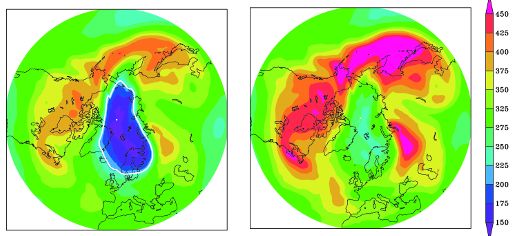
We are already reaping the rewards of the Montreal Protocol, with the ozone layer in much better shape than it would have been without the UN treaty, according to a new study in Nature Communications.
Study lead author Professor Martyn Chipperfield, from the School of Earth & Environment at the University of Leeds, said: “Our research confirms the importance of the Montreal Protocol and shows that we have already had real benefits. We knew that it would save us from large ozone loss 'in the future', but in fact we are already past the point when things would have become noticeably worse.”
Although the Montreal Protocol came into force in 1987 and restricted the use of ozone-depleting substances, atmospheric concentrations of these harmful substances continued to rise as they can survive in the atmosphere for many years. Concentrations peaked in 1993 and have subsequently declined.
In the new study, the researchers used a state-of-the-art 3D computer model of atmospheric chemistry to investigate what would have happened to the ozone layer if the Montreal Protocol had not been implemented.
Professor Chipperfield said: “Ozone depletion in the polar regions depends on meteorology, especially the occurrence of cold temperatures at about 20km altitude – colder temperatures cause more loss. Other studies which have assessed the importance of the Montreal Protocol have used models to predict atmospheric winds and temperatures and have looked a few decades into the future. The predictions of winds and temperatures in these models are uncertain, and probably underestimate the extent of cold winters.
“We have used actual observed meteorological conditions for the past few decades. This gives a more accurate simulation of the conditions for polar ozone loss.”
The researchers suggest that the hole in the ozone layer over the Antarctic would have grown in size by an additional 40% by 2013. Their model also suggests that had ozone-depleting substances continued to increase, the ozone layer would have become significantly thinner over other parts of the globe.
Professor Chipperfield said he undertook this study because of the exceptionally cold Arctic winter of 2010/11.
“We could see that previous models used to predict the impact of the Montreal Protocol in the future would not have predicted such extreme events and we wondered how much worse things could have been if the Montreal Protocol had not been in place,” he said.
Without the Montreal Protocol, the new study reveals that a very large ozone hole over the Arctic would have occurred during that cold winter and smaller Arctic ozone holes would have become a regular occurrence.
The Montreal Protocol has been strengthened over time through amendments and adjustments, supported by ongoing research. The researchers behind the new study say that scientists must continue to monitor the situation to ensure all potential threats to the ozone layer are mitigated.
Further information
The research was partially funded by the Natural Environment Research Council (NERC) through its National Centre for Atmospheric Science (NCAS) and the National Centre for Earth Observation (NCEO).
The research paper, ‘Quantifying the Ozone and UV Benefits Already Achieved by the Montreal Protocol’, is published in the journal Nature Communications on 26 May 2015.
Professor Martyn Chipperfield is available for interview. Please contact Sarah Reed, Press Officer at the University of Leeds, on 0113 34 34196 or email s.j.reed@leeds.ac.uk.
Image - Caption: Arctic ozone without the Montreal Protocol (left) and following its implementation (right) on 26 March 2011. Credit: Sandip Dhomse